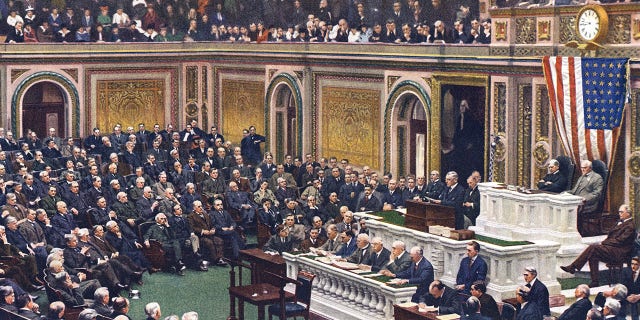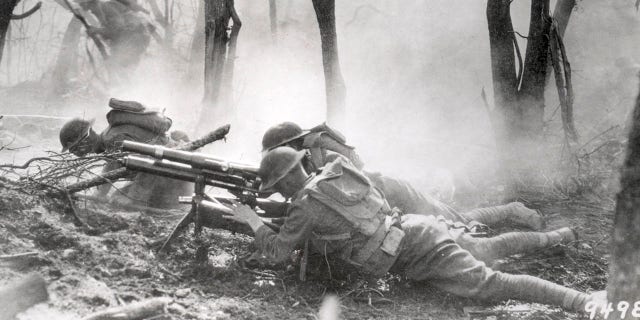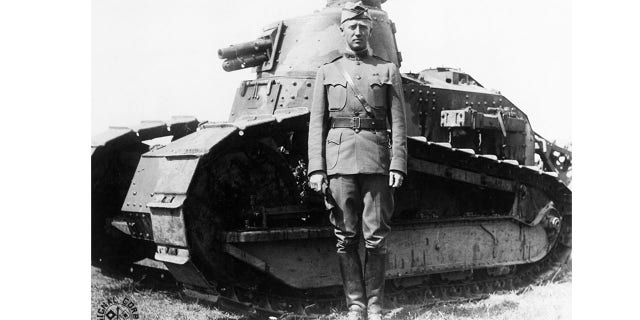On this day in history, April 6, 1917, US enters World War I as Congress votes to declare war on Germany
America sent 'the word over there that the Yanks are coming' amid shocking German threats
The United States plunged ferociously into World War I following a vote in the House of Representatives on this day in history, April 6, 1917.
President Woodrow Wilson requested a declaration of war against Germany before a joint session of Congress on April 2, as the United States faced both the threat of unrestricted submarine warfare from Germany and the potential of its alliance with Mexico to seize vast swaths of the American West.
The Senate voted in favor of the war declaration two days later.
Congress concurred on April 6.
ON THIS DAY IN HISTORY, APRIL 5, 1908, ACTRESS BETTE DAVIS BORN IN MASSACHUSETTS: ‘STRONG-WILLED WOMAN’
The United States was now committed to the tragic Great War, which had consumed much of Europe since 1914.
The declaration came just five months after Democrat Wilson narrowly won reelection over Republican challenger Charles Evan Hughes by campaigning for peace.

President Woodrow Wilson addresses Congress to declare war on Germany in World War I 1917. (Universal History Archive/Universal Images Group via Getty Images)
"The present German submarine warfare against commerce is a warfare against mankind," Wilson said in his April 2 address.
"The challenge is to all mankind. Each nation must decide for itself how it will meet it." — Woodrow Wilson to Congress, April 1917
"It is a war against all nations. American ships have been sunk, American lives taken … and people of other neutral and friendly nations have been sunk and overwhelmed in the waters in the same way. There has been no discrimination. The challenge is to all mankind. Each nation must decide for itself how it will meet it."
Germany sparked outrage in the United States when one of its submarines sank the British cruise ship Lusitania in 1915, killing 1,200 people, including 128 Americans.

Yet the U.S. resisted entry into the war.

(Original Caption) 1/25/1918 in Pipus, France: General Pershing (1860-1948), Marshall (1880-1959), Joffre (1852-1931), and party arrive at Pipus, France, where Lafayette is buried. (Getty Images)
Germany briefly agreed to end unrestricted submarine attacks in 1916, but reneged on its promise in January 1917.
The renewed threat was accompanied by news on March 1 that officials in Britain had decoded the infamous Zimmerman Telegram.
MEET THE AMERICAN WHO INSPIRED THE NATION IN TWO WORLD WARS: CHRISTIAN SOLDIER SGT. ALVIN YORK
The message from German Foreign Minister Arthur Zimmermann to Mexican leaders offered to help America's border rival capture U.S. territory it lost during the Mexican-American War of 1846-48.
"The Zimmermann Telegram galvanized American public opinion against Germany once and for all," writes the National World War I Museum. \
"The Zimmermann Telegram galvanized American public opinion against Germany once and for all." — National World War I Museum
The American people, long desperate to avoid sending their boys to fight and die on foreign soil, responded with a nationwide burst of patriotic commitment to the cause in alliance with France and Great Britain.

Nearly 1,600 American soldiers, almost all killed in World War I, rest in eternal reverence on a hill overlooking the Eiffel Tower and the sprawl of Paris at the Suresnes American Cemetery. It's one of nearly two dozen American cemeteries and memorials in Europe honoring U.S. troops killed in WWI. (Kerry J. Byrne/Fox News Digital)
"George Cohan’s ‘Over There,’ composed a day after America’s declaration of war, summed up the spirit and confidence of the day," writes the United States World War I Centennial Commission, while the president "ordered ‘The Star-Spangled Banner’ be played at all military and other appropriate occasions."
The defiant tune of American resolve, not yet the national anthem, was played during the seventh-inning stretch of each game of the 1918 World Series.
AMERICAN SOLDIERS KILLED IN WWI REMEMBERED FOREVER IN NYC ALE HOUSE
There are no reports of players kneeling.
The patriotic World Series performance sparked what's become a pre-game tradition at sporting events in the United States.
"Lafayette, we are here!" — Col. Charles Stanton to the French people on behalf of Gen. John Pershing
The American Expeditionary Force, commanded by Gen. John Pershing, landed in France in June amid great fanfare and greater hope from desperate Allies entrenched in horrific combat at the cost of millions of lives.

U.S. soldiers of the 23rd Infantry, 2nd Division, firing a 37mm machine gun at a German position in the Argonne Forest, during the Meuse-Argonne offensive, Sept. 26-Nov. 11, 1918. (US Army Signal Corps/Education Images/Universal Images Group via Getty Images)
The AEF marched through Paris on July 2 for a ceremony at the grave of the Marquis de Lafayette.

The teenage French nobleman flouted the orders of King Louis XVI to fight heroically in the cause of the American Revolution.
ON THIS DAY IN HISTORY, SEPT. 6 1757, MARQUIS DE LAFAYETTE IS BORN, HERO OF TWO REVOLUTIONS
"Lafayette, we are here!" Col. Charles Stanton proclaimed on behalf of Gen. Pershing, acknowledging that the United States had come to repay its debt to France.
The cost was tragic.
Over 116,000 American doughboys were killed, and 204,000 more wounded, from the time U.S. forces entered combat in October 1917 to the end of the war just a year later, in November 1918.
Over 116,000 American doughboys were killed, and 204,000 more wounded, in just one year of combat in World War I.
Gen. Pershing led massive offensives in the autumn of 1918 that broke the four-year stalemate on the Western Front, most notably the Meuse-Argonne Offensive from September through November.

James Montgomery Flagg's Uncle Sam "I Want You" 1917 WWI recruiting poster has become one of the most enduring images in U.S history. (Getty Images)
"The Meuse-Argonne Offensive was the largest operation of the American Expeditionary Forces (AEF) in World War I, with over a million American soldiers participating," according to the National Archives.

The United States suffered a staggering 120,000 casualties, including more than 26,000 doughboys killed in action, in just six weeks of combat.
CLICK HERE TO SIGN UP FOR OUR LIFESTYLE NEWSLETTER
The sweeping offensive captured 200 square miles of German-held territory in France — an incredible gain among sides that fought bitterly over inches for years — and effectively won the war.
More than 14,000 U.S. soldiers troops are buried today in the Meuse-Argonne American Cemetery in France, the largest resting place among the dozens of cemeteries for American war dead in Europe.
ON THIS DAY IN HISTORY, FEB. 21, 1916, CATASTROPHIC BATTLE OF VERDUN BEGINS WITH GERMAN ATTACK ON FRANCE
Many celebrated American military heroes fought as young soldiers in Europe in World War I and later led the Allied effort in World War II.
Among them: George C. Marshall, Douglas MacArthur and George S. Patton.

Dwight Eisenhower, the Supreme Allied Commander in Europe in World War II, served stateside in World War I.

George S. Patton Jr. poses with a tank from his tank corps during a command as a lieutenant colonel in France during World War I. (Photo by © CORBIS/Corbis via Getty Images)
"By the time Germany signed the Armistice on November 11, 1918, the American Expeditionary Forces had evolved into a modern, combat-tested army recognized as one of the best in the world," writes the Library of Congress.
"World War I provided the United States with valuable strategic lessons and an officer corps that would become the nucleus for mobilizing and commanding 16 million American military personnel in World War II."
No comments: